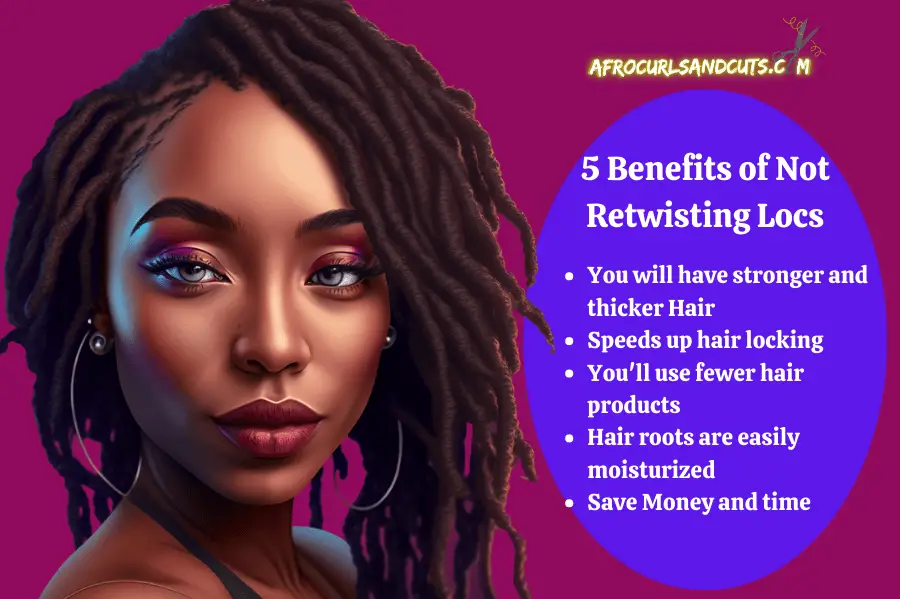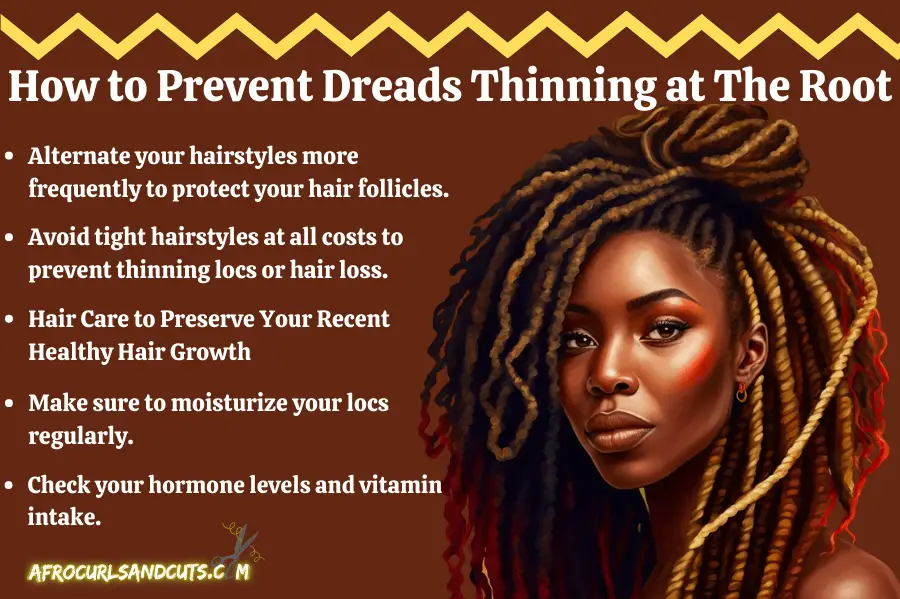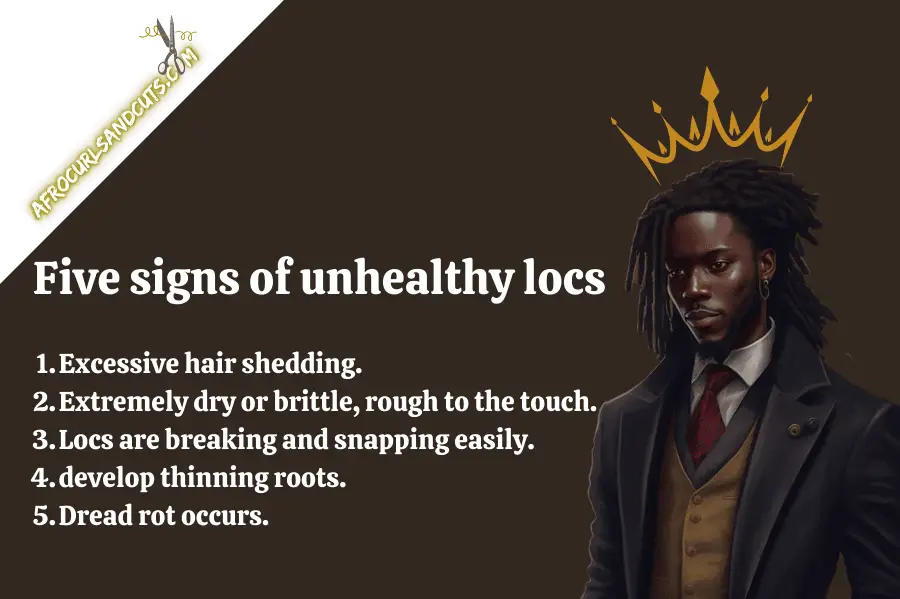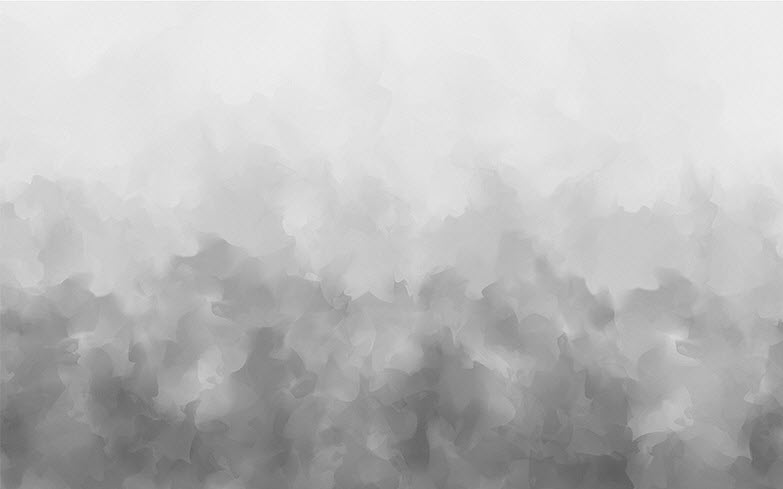We may earn money or products from the companies mentioned in this post.
Overview
5 Benefits of Not Retwisting Locs: Stop Thinning & Breakage
This article contains information about the benefits of not retwisting locs and the three signs of unhealthy locs. We’ll discuss the pros and cons of not retwisting and provide tips on keeping your locs healthy.
Click here for Amazon Annual Audible Membership!
Thick hair is one of the signs of healthy dreads. Twisting can cause thinning.
Have you found yourself needing to style your hair more often than necessary?
Have your locs been thinning lately? Simply retwisting your locs might be easier than letting the coils form independently, but it can result in the dreads thinning.
Due to the low maintenance requirements and associated costs of locs, they are both cost-effective and convenient to maintain.
However, the fastest way to ruin locs is to do too much with them. Palm rolling and retwisting too often can sometimes be why your hair is thinning and the roots aren’t growing as strong as they should.
In this article, we’re discussing the benefits of not retwisting your locs.
Why shouldn’t I retwist my Dreadlocks?

Constantly retwisting locs is terrible for your hair and scalp. Although it may look sturdy, your dreads are fragile and easily broken by tugging and twisting. If the hair follicles or strands are damaged, the hair could fall out.
Hair loss is one of the most common problems with dreadlocks, and it can be caused by stress on your scalp. The hair follicle, the tissue from which individual hairs sprout, can be weakened. Your hairline and other areas around your scalp may begin to thin over time.
Therefore, by not retwisting your locs, your hair grows and twists by itself, which reduces the risks of scalp infections.
This is beneficial because moisture retention increases as your hair grow, making it healthier and more resistant to further damage and traction alopecia.
Dreadlocks are well-known for preventing hair loss and thinning hair. However, the repeated pressure and severe stress from twisting cause the hair to weaken at the root if done too often.
Eventually, freeform locs will result in thicker tresses, and who doesn’t like to keep their natural hair healthy? So, either don’t retwist your locs or only do it sometimes.
5 Benefits of Not Retwisting Locs

You will have stronger and thicker Hair
Dreadlocks are well-known for protecting hair from breakage and thinning. However, over-twisting your hair will strain your follicles and roots, weakening your hair.
Speeds up hair locking
When you reduce constant manipulation like palm rolling and or loc interlocking, you are giving your locs a chance to lock on their own. This can reduce the time it takes for your hair to fully dread.
You’ll use fewer hair products
With less re twisting means, fewer products are needed to maintain your locs. Surely this benefit should be at the top of the list.
Hair roots are easily moisturized
The foundation of your locs is the roots. If your roots are not moisturized, your locs hair grows unhealthy and causes thinning or, worst loc breakage.
Save Money and time
In the U.S., two things most people can not get enough of is time and money. Not retwisting locs will save you both. No need to spend time or money at the salon getting your locs re twist.
7 Tips to Stop Dreads Thinning for New Hair Growth
Several factors can cause thinning hair, and knowing the exact problem will help you figure out how to address it. Next, we will list various reasons behind your dread roots becoming thinner.
1. Avoid retwisting.
You can avoid traction alopecia and thinning dreads by dodging tight and repeated hair retwisting—request a more relaxed treatment from your lotician.
2. Protect your hair.
Sleep with a satin cap, bonnet, or pillowcase to protect your head and neck. When getting ready for bed, stay away from any headwrap that is too snug.
3. Shorter hair.
If it’s possible, try to keep your dreads shorter. The constantly pulling weight and pressure of having lengthy dreadlocks on your head might cause hair damage at weak spots.
4. Avoid tight styling.
You can prevent thinning dreads and alleviate some of the stress on your scalp by avoiding certain styles and hair accessories. Some examples are twisting styles, rubber bands, and tight ponytails.
5. Wash often.
Some hold the opinion that washing your dreadlocks frequently is unnecessary.
However, washing your hair regularly maintains its health and promotes new growth.
There are a variety of recommendations, but it is recommended that you go up to two to three weeks without shampooing or conditioning.
6. Less UV.
Take steps to limit your time spent in the sun. Continuous exposure to UV rays will retard growth, causing thinning locs and leading to further hair loss.
Excess heat during the summer months can cause your hair to become dry and brittle and even damage your hair follicles.
When spending an extended amount of time outside, be sure to cover your hair.
7. Use oils.
Essential oils maintain healthy hair without causing it to become brittle or clogged.
Tea tree oil, peppermint oil, and black castor oil are just a few of the natural oils that help prevent thinning.
How to Prevent Dreads Thinning at The Root

Hair thinning is a dreadlocked nightmare; hair needs to be thick, healthy, and vital to retain length.
Preventing thinning roots protects your hair follicles and avoids alopecia. Here are some hair care tips to help:
Alternate your hairstyles more frequently to protect your hair follicles.
Always take breaks from styling your hair to prevent traction alopecia, thinning, and hair loss.
Put in the effort to avoid spending days on end with your hair pulled back in a ponytail, buns, pigtails, or any other type of updo.
Don’t be afraid to let your locs down. Because of the decreased stress on the scalp, less hair loss and thinning will occur. Your hair will begin to regrow after some time has passed.
Avoid tight hairstyles at all costs to prevent thinning locs or hair loss.
You should avoid squeezing your dreadlocks too tightly when styling them. Hair loss and breakage from tight hairstyles are common complaints.
However, many locticians over-tighten their clients’ hair to create complex, tidy looks.
Tell your loctician ahead of the appointment that you don’t want tight styling next time you get your hair done professionally.
Hair Care to Preserve Your Recent Healthy Hair Growth
Many people, to maintain a clean appearance, retwist their locs excessively. To prevent hair loss, please follow these loc maintenance guidelines.
Retwisting should be done at most every four to six weeks and never too firmly.
After every six to eight weeks, schedule a space interlocking maintenance appointment.
Retwist locs in a circular direction always; twisting in the wrong direction can cause too much tension.
When you lock your hair, you must realize that it won’t always be perfect. When you have new growth of at least a couple of inches, crocheting should be attempted.
After that is recognized, scheduling adequate time for maintenance intervals is better.
Make sure to moisturize your locs regularly.
You might have heard that you should dry out your locs when you initially got them to hasten the locking process.
However, because your hair requires moisture to grow, this can cause hair loss.
Locs shouldn’t be coated in heavy products, but they do need a gentle misting now and then to prevent them from drying out.
An easy method is to spray rose water on your dread roots and locs and then follow up with light oil to lock in the moisture.
If your locs are properly hydrated, they will be less likely to break under the stress of regular upkeep and styling.
Your dread roots can thicken once you start a regular loc hydration program.
Check your hormone levels and vitamin intake.
It’s important to ensure you eat a balanced diet and get enough vitamins. Especially those that promote healthy hair growth since vitamin shortages are a common cause of thinning locs.
Food is an excellent source of vitamins and minerals (zinc, biotin, selenium, vitamin D, and iron).
However, dietary supplements like folic acid are available to help those who struggle with poor nutrition.
Consult your doctor if you think hormonal changes are to blame for your thinning locs. They can rule out the possibility of hormone issues.
Medical treatments for the underlying hormonal imbalance should result in normal hair growth and stronger hair at the scalp’s base. Your loc journey will be much easier if you take care of your health first.
Five signs of unhealthy locs

Below are the five signs of unhealthy deadlocks:
- Excessive hair shedding.
- Extremely dry or brittle, rough to the touch.
- Locs are breaking and snapping easily.
- develop thinning roots.
- Dread rot occur
Signs of Healthy Locs
If you frequently retwist your dreads, you risk damaging your scalp with excessive tension and making it dry.
But once you let your hair be, you will notice thinning roots reduce, and signs of healthy roots begin to pop up.
It retains moisture better.
Not retwisting your locs will prevent breakage and allows your scalp to retain moisture, promoting greater hair growth.
As a result, your dreadlocks will thicken and look fantastic. Reduced outdoor exposure also protects the scalp from the harmful effects of dirt and pollution.
It requires less maintenance.
Keeping twisted locks in good condition is much work compared to letting your hair grow.
They could break off at any time. Since this is the case, you’ll need to experiment with various methods to maintain the dreads’ twists.
Using gel and avoiding moisture are both detrimental to hair health. Hair gel is frequently used to achieve the desired matte finish and prevent hair from sticking out from twisted locks. If you want the locs to stay in place, you should avoid getting them wet.
Your twists form on their own.
The process of hair transitioning into locs is a natural one that requires patience.
Although it’s cool to retwist your locs now and then, doing it too frequently will damage your natural locs and render them unusable.
Retwisting locs that have already formed will undo the natural form and apply more tension.
You will speed up the process of getting locs by being less controlling of them.
Not retwisting your locs allows conditioner and other treatments to penetrate the new hair shaft and nourish the dread roots.
Cleaning the areas of the scalp that the locs conceal is also simplified.
Conclusion
A significant investment of time, energy, and resources is required for loc retwisting. You’d have to first make an appointment with the hairdresser. When you think about the benefits of not retwisting locs
That can be expensive because the stylist might use several hair products and harmful chemicals that claim to soften and thicken your locks.
When you think about the benefits of not retwisting locs, you realize that it is a more natural and low-maintenance approach.
Simple dreadlocks, however, do not require the assistance of a professional or the application of any substance.
Relax and let the hair rest for a while. Stress-free, healthy, and lush new hair; are the key benefits of not retwisting your locs.
If you found value and enjoyed this article, please like, share, and subscribe to AfroCurlsandCuts.com! Don’t forget to check out our social media accounts as well.


